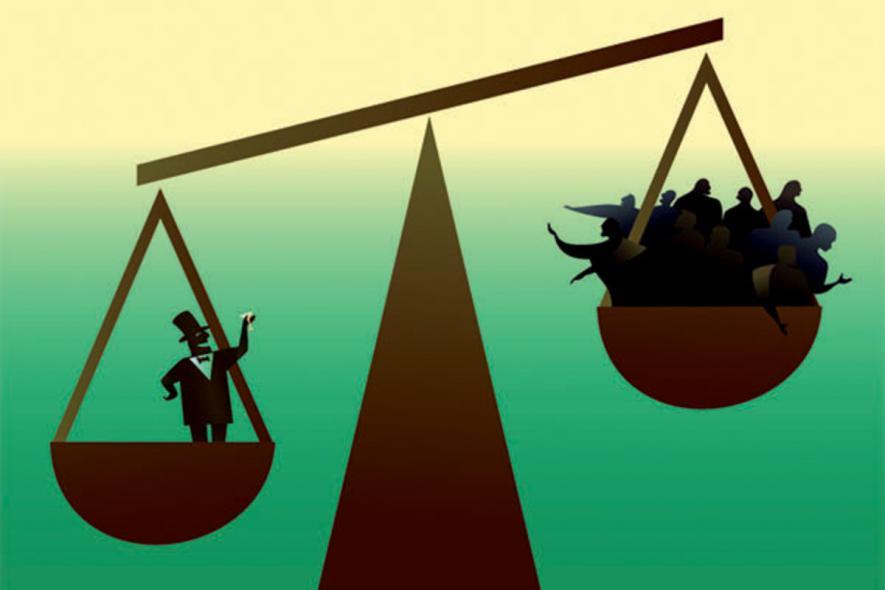Wealth Inequality: Capitalism Versus Socialism

Much has been written about the immense increase in economic inequality that has occurred of late and various startling figures have been provided by bodies like Oxfam, which has just come out with a report titled Inequality Kills. This shows that the wealth of the 10 richest men has doubled since the pandemic began while the incomes of 99% of the population of the world are lower today than before the pandemic. A mere 0.027% of the world’s population is estimated to have owned a combined wealth of $45 trillion in 2020, which is more than 15 times the current gross domestic product or GDP of India.
Some have even claimed that the contemporary world is characterised by the highest level of economic inequality ever witnessed in human history (MR Online, February 12). This claim is by no means implausible. Since every social system needs production, and since producers have to be given some minimum level of subsistence, there is a floor to what even the poorest must have access to, no matter how low the level of their labour productivity; and this is true even of earlier social systems.
On the other side, the share of economic surplus, which is the difference between labour productivity and the wage rate of productive workers, can keep rising as labour productivity rises with the development of productive forces. As capitalism has witnessed the highest level of development of productive forces to date, it should come as no surprise if economic inequality under capitalism in the sense of the share of economic surplus in output is higher today than at any earlier time.
The obvious argument against this view would be that with the development of the productive forces there would also be an increase in the real wage rate of the productive workers, so that the share of economic surplus, and hence the level of inequality that typically is an offshoot of it, need not increase under capitalism compared with earlier modes of production.
But if we see capitalism in its international setting where it causes deindustrialisation in its periphery and hence builds up massive labour reserves that keep real wages pretty close to a subsistence level despite the substantial increase in labour productivity, then it follows that inequality defined in terms of the share of surplus in the world as a whole would be much higher under capitalism than under earlier modes of production, precisely because of the greater development of the productive forces it ushers in compared with earlier modes.
But even as inequality in this sense is greater today than at any other time in human history because of the capitalist mode, barely three decades ago there existed societies where inequality was lower than ever before in human history. I refer, of course, to the erstwhile Soviet Union and the other socialist countries of Eastern Europe.
After the collapse of socialism in those countries, it has become fashionable to talk of them as being effectively no different in this respect from the capitalist countries, with an “apparatchik” that lived off the surplus exactly as capitalists do. But this attempt at obliterating the differences between the two social systems with regard to inequality is a dishonest ideological manoeuvre, which is factually incorrect. On the contrary, the contrast between the two systems in terms of inequality is simply unimaginable.
Max Lawson of Oxfam quotes Branko Milanovic, an economist of Yugoslav origin, to show that inequality in Eastern European economies (though he uses a different measure from what I have used above) was far less at that time compared with West Germany, France or Denmark, not to mention the US where, of course, it was much greater.
And this lower inequality, according to Milanovic, was because of at least three factors. The first was the massive expropriation of private, especially feudal, property after the Bolshevik Revolution, and its distribution among the peasants; similar land redistribution was carried out in many other Eastern European countries after the war.
The second was the fact that everybody had access to free education and healthcare. Every student received not only free education but also a stipend to study, and since there were no private colleges and universities, all received the same education and had the same opportunities for advance open to them; there was no question of some students, from a so-called “affluent” background being better placed compared with other students.
And the third factor was guaranteed employment; everyone was assured of a job, there being no question of some remaining unemployed and constituting a reserve army of labour, as occurs under capitalism.
These factors however, though important, do not fully explain the greater equality under socialism. These have to be supplemented by the very logic of the socialist system that prevented any increase in inequality. The economy’s being forever at full employment gave the former socialist economies a dynamic that was fundamentally different from that of capitalism.
Under capitalism income distribution is determined separately and independently, through bargaining between workers and capitalists, in which the workers are handicapped by the existence of the reserve army: the greater the relative size of the reserve army, the lower is the wage share that the workers can obtain through their bargaining.
These independently given shares of workers and capitalists in output are the reason why there are crises of over-production in capitalism. If the relative share of workers, that is, their real wage divided by labour productivity, is, say half, and the total production capacity of the economy is 100, then 50 would come to the workers and 50 to the capitalists if full capacity output is produced.
The workers more or less consume what comes to them; but if capitalists’ consumption (including the consumption of their “hangers-on”) and investment, which are decided upon independently, add up to only 40, then only 40 of the surplus will be “realised”, and, since the share of surplus is half, workers will get 40 and not 50, and the “realised” total output will be 80. This means that 20 of producible output will remain unproduced, and if labour productivity is, say, 1, then 20 more workers will be unemployed over and above those who would have been unemployed anyway if 100 had been produced.
In a socialist economy, however, if the sum of investment and consumption by state personnel including managers (there are no capitalists and hence no capitalists’ consumption) is 40, then the output will still remain at 100, namely, at its full capacity level and the extra amount will simply be given to workers. The workers’ share will be adjusted upward, so that they get 60 through a fall in prices relative to money wages. The workers’ share, in other words, instead of being given independently, is itself flexible, always adjusting so as to realise the full capacity output.
Thus, while a capitalist economy has unemployment in the event of insufficient aggregate demand, a socialist economy never has insufficient aggregate demand because the share of wages always adjusts to offset any such possibility. The share of economic surplus in output, therefore, can rise secularly, and correspondingly the share of wages in output can fall secularly, only if the ratio of investment to output rises secularly. But even in such a case since there are no private capitalists owning the means of production, this entire rise in economic surplus comes to the State and there is no increase in income or wealth inequality among individuals.
Thus, the very logic of the functioning of the socialist system was such that it ruled out any over-production crises, any unemployment and any tendency toward growing income or wealth inequality among individuals. What is more, the transition to such a remarkably egalitarian system from an earlier system marked by massive inequality, occurred within a very short span of time. As one of Lawson’s interlocutors puts it: “You had situations where parents were illiterate and their sons became university professors”.
Some people believe that one cannot have creativity in a society characterised by substantial equality, for such equality undermines incentive. But this is a flawed argument for two obvious reasons. First, it is myopic in believing that the mainsprings of creative endeavour lie only in monetary incentives. In other words, this argument justifies a bourgeois order by making assumptions about human nature that limit it only to what one witnesses within a bourgeois order.
And second, it does not reckon with the massive loss of creativity (quite apart from the human costs involved) that is entailed when the mass of the population is kept uneducated, unemployed, in poor health, and nutritionally deprived
Get the latest reports & analysis with people's perspective on Protests, movements & deep analytical videos, discussions of the current affairs in your Telegram app. Subscribe to NewsClick's Telegram channel & get Real-Time updates on stories, as they get published on our website.
























